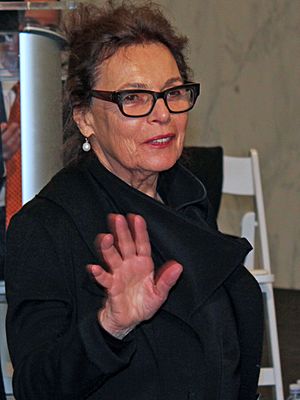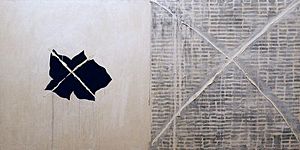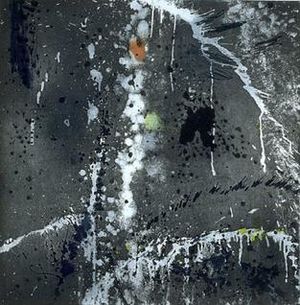Pat Steir facts for kids
Quick facts for kids
Pat Steir
|
|
|---|---|

Steir in 2014
|
|
| Born | 1940 |
| Nationality | American |
| Education | Pratt Institute Boston University College of Fine Arts |
| Known for | Painting, printmaking |
| Awards | Guggenheim Fellowship (1982); Pratt Institute honorary doctorate (1991); Boston University Distinguished Alumni Award (2001); Pratt Institute Alumni Achievement Award (2008) |
Pat Steir, born in 1940, is a famous American artist. She creates amazing paintings and prints. At first, her art was a bit like 'conceptual art' and 'minimalism'. But she is most famous for her 'Waterfall' paintings. These are abstract artworks made by dripping, splashing, and pouring paint. She started these in the 1980s. She also makes large drawings directly on walls.
Pat Steir's art has been shown all over the world. This includes the Tate Gallery in London and the Brooklyn Museum in New York. Her shows have traveled across Europe. She has won many awards for her art. Her work is kept in major museums in the United States and other countries. These include the Metropolitan Museum of Art and the Museum of Modern Art in New York City.
She helped start Printed Matter, a bookshop in New York City. She also helped create Heresies, a special art journal first published in 1977. Steir has taught art at Parsons School of Design and Princeton University. She has mostly lived and worked in New York City. Today, she lives in Greenwich Village.
Contents
Early Life and Education
Pat Steir was born Iris Patricia Sukoneck in 1940. Her hometown was Newark, New Jersey. She went to the Pratt Institute in New York from 1956 to 1958. There, her teachers Richard Lindner and Phillip Guston inspired her. She also studied at Boston University College of Fine Arts from 1958 to 1960. Steir returned to Pratt and finished her art degree in 1962.
Pat Steir's Art Career
Starting as an Artist

In 1962, the year she graduated, Steir's art was shown in a group exhibition. This was at the High Museum of Art in Atlanta, Georgia. In 1964, her drawings were part of a show at the Museum of Modern Art in New York. Her very first solo art show was in 1964 at the Terry Dintenfass Gallery in New York.
During this time, she worked as an illustrator and book designer in New York. From 1966 to 1969, Steir was an art director at Harper & Row publishing company. Around 1970, she became friends with artists like Sol LeWitt. She also began visiting artist Agnes Martin in New Mexico many times.
She became well-known in the 1970s. She made paintings of roses or other images that were crossed out. Steir explained that she wanted to "destroy images as symbols." She wanted the image to be a symbol for a symbol. Nothing, from 1974, is a good example of her work from this time. This painting is now in the Honolulu Museum of Art.
Developing Her Unique Style
Pat Steir's first museum exhibition was in 1973. It was held at the Corcoran Gallery of Art in Washington, D.C. This marked the start of her busy career with many painting shows. She also creates installation art, which are artworks made for a specific space. She is also an important printmaker.
Crown Point Press started publishing her prints in 1977. In 1983, the Spencer Museum of Art showed her prints and drawings. A large show of her prints traveled from Geneva to the Tate Gallery in London. Steir had solo painting shows at the Brooklyn Museum in 1984 and the New Museum of Contemporary Art in New York in 1987. These shows also traveled to other museums, especially in Europe.
In the late 1980s, Steir was inspired by artists John Cage and Agnes Martin. She began making paintings by dripping, splashing, and pouring paint. She let chance play a role in her art. She connects this work to ancient Chinese "ink-splashing" painters. She studied how ink splashes in nature and was inspired by Tibetan philosophy. Wind and Water is an example of this type of work.
From 1989 to 1992, Steir started using only one color in her paintings. In 1995, a book about her art, called Pat Steir, was published. It was written by art critic Thomas McEvilley. In 1999, Steir was featured on the cover of Art in America magazine. The article said her waterfall paintings showed her interest in Asian art and Daoism. This ancient Chinese philosophy focuses on the flow of water.
In 2010, Steir created an installation called The Nearly Endless Line. It was a white line winding around blue-black walls, lit with blue light. One art critic said that walking through it made observers feel like they were inside Steir's painting. Pat Steir once said she wanted to be a "great artist." She meant someone who could truly touch the souls of other people.
Awards and Recognition
Pat Steir has received many awards for her art. She received grants from the National Endowment for the Arts in 1973 and 1976. She also won a Guggenheim Fellowship for Fine Arts in 1982. Both of her old schools have honored her. Pratt Institute gave her an Honorary Doctorate in 1991 and an Alumni Achievement Award in 2008. Boston University gave her a Distinguished Alumni Award in 2001. In 2016, Steir became a member of the American Academy of Arts and Letters.
Exhibitions
Pat Steir has shown her art for over fifty years. She has exhibited in many galleries and museums. These are all over the U.S. and around the world. Some galleries where she has had solo shows include Terry Dintenfass Gallery and Robert Miller Gallery.
Museums and institutions that have shown her work include:
- Corcoran Gallery of Art (1973)
- Brooklyn Museum (1984)
- Museum of Fine Arts Bern (1987)
- Musée d'art contemporain de Lyon (1990)
- Rhode Island School of Design Museum (2010)
- Silent Secret Waterfalls: The Barnes Series, Barnes Foundation, 2019.
- Pat Steir: Color Wheel, the Hirshhorn Museum and Sculpture Garden, 2019.
Collections
Pat Steir’s art is part of major public collections worldwide. These include:
- Metropolitan Museum of Art (New York City)
- Museum of Modern Art (New York City)
- Whitney Museum of American Art (New York City)
- Solomon R. Guggenheim Museum (New York City)
- National Gallery of Art (Washington, D. C.)
- Tate Gallery (London)
- Phoenix Art Museum (Phoenix, Arizona)
- Honolulu Museum of Art
- Walker Art Center
- San Francisco Museum of Modern Art
- Baltimore Museum of Art
- Lyon Museum d’Art Moderne, France
- The Long Museum, Shanghai
- Kunstmuseum Bern, Switzerland
- Malmo Museum, Sweden


